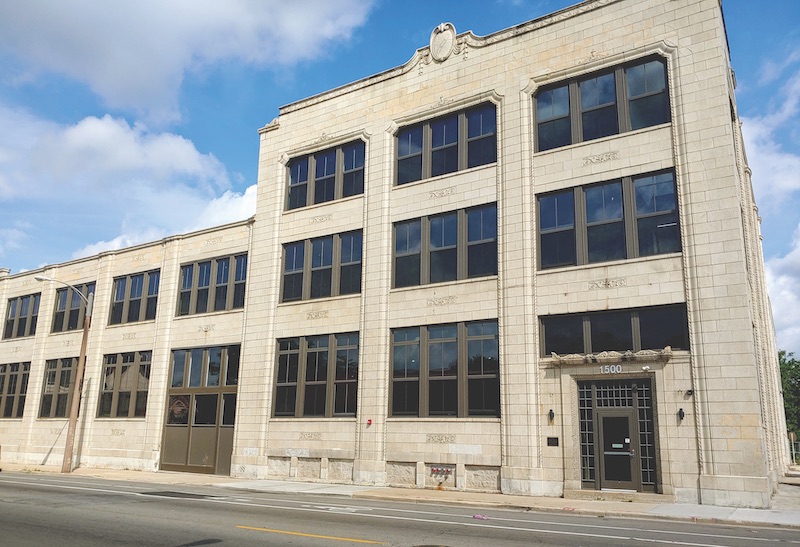David Block fell in love with the Blommer Ice Cream Company factory the nanosecond he first saw it, seven years ago. Block, an architect, city planner, and Director of Development with Evergreen Real Estate Group, Chicago, was on a scouting mission to Milwaukee to scope out development opportunities.
“It really caught my eye,” he recently recalled, as we gazed at the building from across North Avenue. “All the beautiful windows were blocked up, but it had a presence that called to me. I knew immediately that I wanted to do something with it.”
Block soon heard about Sally Peltz, Founder (now Board Member) of the nonprofit Legacy Midwest Renewal Corporation. “We were looking for a stellar project for workforce housing for the neighborhood,” said Peltz, a Milwaukee native and activist. In short order she and Block formed an alliance to convert the three-story industrial structure into much-needed rental housing.
It took a dedicated project team six years to pull off, but last December, Legacy Lofts began leasing its 64 apartments, 54 of which were set aside for families below 60% AMI, including 16 for the homeless. Legacy Lofts is now 100% occupied and, as we shall see, has become a beacon of hope for the struggling Lindsay Heights neighborhood.
But first, let’s time travel back a century and a half and meet Conrad Blommer.
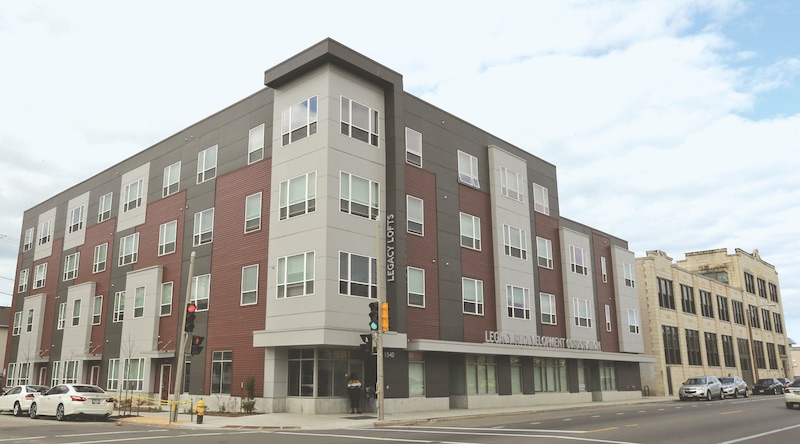 The addition to the original Blommer factory, Legacy Lofts. Photo: Tricia Shay.
The addition to the original Blommer factory, Legacy Lofts. Photo: Tricia Shay.
AN ENTERPRISE BUILT ON ICE
Conrad Blommer (pronounced “Blummer”) opened his first candy store and ice cream parlor in Milwaukee in 1870. Forty years later, he built a small ice cream plant at 15th Street and North Avenue. By the early 1920s, with the addition of four factories in Wisconsin, his company was producing half a million gallons a year—8% of all the ice cream made in the state.
To keep up with demand, Blommer commissioned local architect Vernon H. Esser (1891-1970) to design an addition several times larger than the original plant. Esser’s design stressed what he called “the advertising value of beauty and sanitation in industrial buildings.” Completed in 1927 and outfitted with the latest equipment, the two- and three-story factory, clad in cream-colored terra cotta and Italian Renaissance detailing that combined cleanliness with delicacy, began producing ice cream products that were “practically untouched by human hands.”
Not long after the new factory was completed, however, Blommer Ice Cream merged with two other dairies to form Wisconsin Creameries, which operated the plant until 1934. By 2012, when Block happened upon it, the factory had been vacant for decades. It would take six years for Block and Peltz to realize their vision for the property.
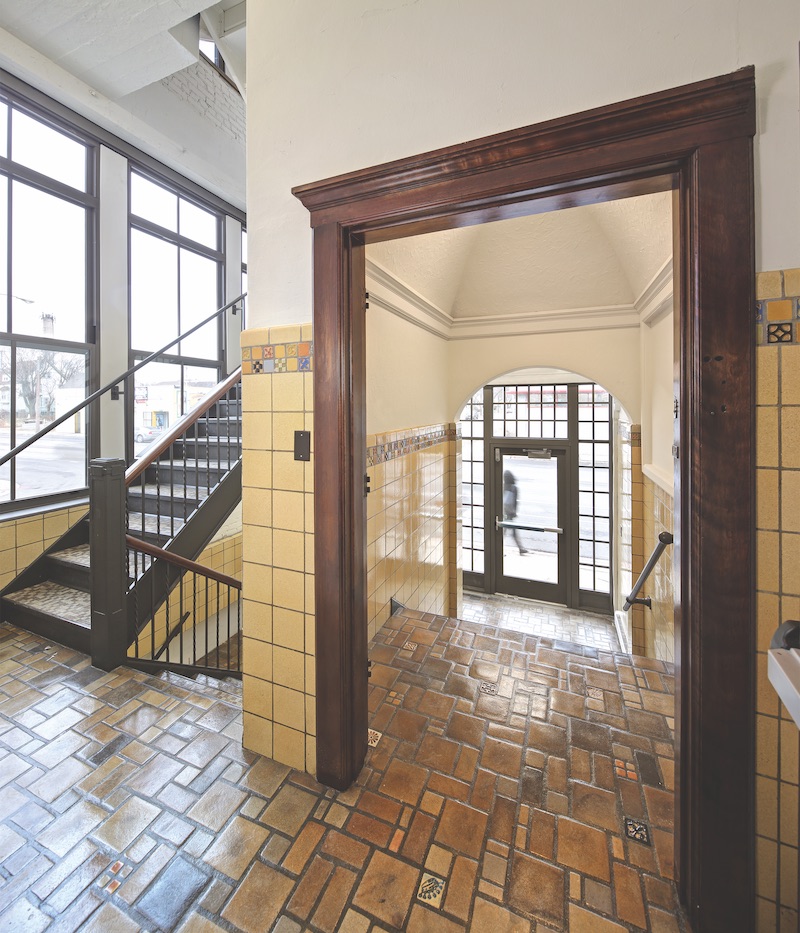 The entry vestibule and stairs feature period floor tiles and tile wainscoting accented with small tiles that purportedly described the many flavors of Blommer ice cream. The State Historic Preservation Officer stated the rehabilitation “successfully incorporated” the entryway and tiles. Photo: Tricia Shay.
The entry vestibule and stairs feature period floor tiles and tile wainscoting accented with small tiles that purportedly described the many flavors of Blommer ice cream. The State Historic Preservation Officer stated the rehabilitation “successfully incorporated” the entryway and tiles. Photo: Tricia Shay.
OVERCOMING STRICT REGULATORY DEMANDS
Financing for the $13.8 million reconstruction of the 45,000-sf Blommer building and 32,000 sf of new construction hinged on getting historic preservation tax credits. MacRostie Historical Advisors guided the application through the State Historic Preservation Officer and the National Park Service (NPS) to get the Blommer plant deemed “locally significant” under the National Register of Historic Places (Criterion A) in late 2017.
The Wisconsin Housing and Economic Development Authority (WHEDA) provided $7.7 million in low-income housing tax credits and an $8.5 million construction loan. Additional funding came from IFF and the Federal Home Loan Bank’s Affordable Housing Program. The project gained a total $2.8 million in historic tax credits. Associated Bank bought the state credits; US Bank bought the federal credits. The city contributed $690,000 in HOME funds and $635,000 through a developer-financed TIF district.
“The multiple layers of financing that allowed this project to go through were very strict in their requirements,” said lead architect Falamak Nourzad, NCARB, AIA, LEED AP, ASID, Principal, Continuum Architects + Planners, a local MWBE design firm with a lengthy record of historic renovations in Milwaukee. “WHEDA dictated that the units had to be a certain size. HUD [U.S. Department of Housing & Urban Development] has guidelines that are well above ADA. And you have to deal with the National Park Service, especially on the exterior.”
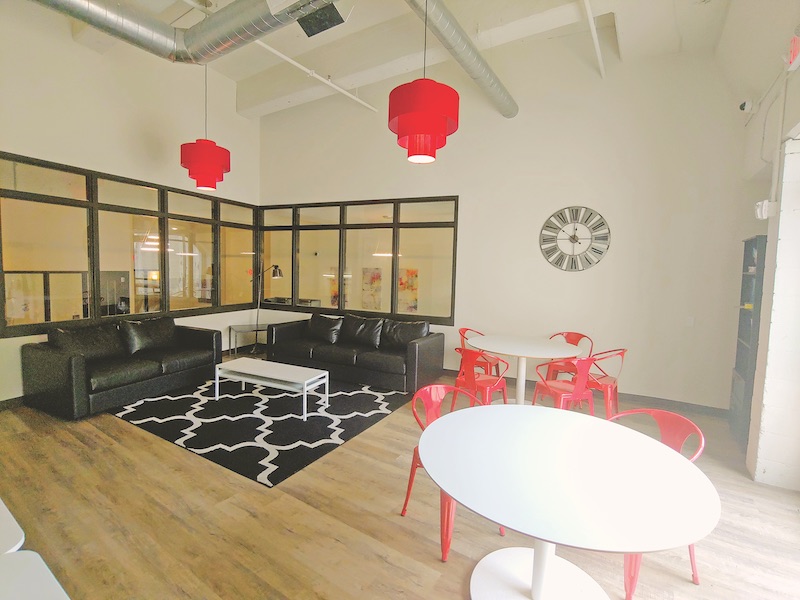 A 450-sf library and multipurpose community room was carved out from the old loading dock. “It gets busy in the afternoon with families and kids reading and doing homework,” said Xavier Shands, On-site Property Manager, Evergreen Real Estate Group. Photo: Roziel Reyes.
A 450-sf library and multipurpose community room was carved out from the old loading dock. “It gets busy in the afternoon with families and kids reading and doing homework,” said Xavier Shands, On-site Property Manager, Evergreen Real Estate Group. Photo: Roziel Reyes.
To meet NPS’s historic preservation requirements, the 26-unit contemporary addition was stepped down from four stories at the western corner to three stories adjacent to the Blommer building. “That cost us a few units, but it worked out in the end,” said Nourzad.
The Wisconsin Historical Society, which acts as the State Historic Preservation Officer, stated, “As a general rule, new construction cannot exceed the height of the historic building. However, a compromise was reached where only the portion closest to the historic building had to be reduced one floor in height and the remaining portions could remain taller.”
Continuum Principal Michael A. Soto, NCARB, AIA, said that, while the Blommer building was structurally sound, the project team took pains to be careful with the terra cotta. “It really is a timeless material,” he said. He commended the NPS and other authorities for being “really willing to listen and work with us.”
See Also: Techno-magnet: Proto Kendall Square
The contemporary design of the new section was purposeful in its intent. “We wanted to be respectful of the old building, but copying it was something that neither we nor the NPS wanted,” said Nourzad.
To overcome a four-foot grade difference in the historic building that made ADA accessibility hard to achieve, Continuum and the contractor, Greenfire Management Service, took advantage of the building’s existing internal grade difference to create a double-height lobby; a resident library/game room overlooks the lobby. The project team was then able to modify the elevator to stop at the lower level for ADA compliance.
The project team outfitted Legacy Lofts with amenities that defy its “primarily affordable” label: a library/community room, the spacious lobby, individual storage, some off-street parking, in-unit washers and dryers, ceiling heights that go up to 20 feet, polished concrete floors, and beautifully restored windows, many as tall as 10 feet.
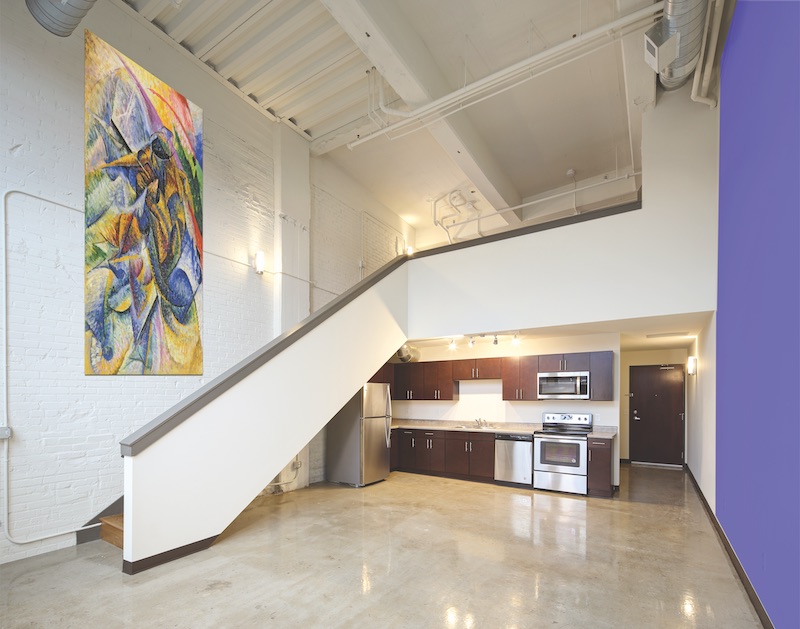 Apartments in Legacy Lofts range in size from 500 to 1,600 sf. Townhomes in the new addition measure 1,200 to 1,400 sf. Units have generous ceiling heights, as much as 20 feet in some cases. Legacy Redevelopment Corp., the lending arm of co-developer Legacy Midwest Redevelopment Corp., has an office in the new construction portion of Legacy Lofts. Photo: Tricia Shay.
Apartments in Legacy Lofts range in size from 500 to 1,600 sf. Townhomes in the new addition measure 1,200 to 1,400 sf. Units have generous ceiling heights, as much as 20 feet in some cases. Legacy Redevelopment Corp., the lending arm of co-developer Legacy Midwest Redevelopment Corp., has an office in the new construction portion of Legacy Lofts. Photo: Tricia Shay.
THE POWER OF POSITIVE THINKING
Does the success of Legacy Lofts signal a turnaround for Lindsay Heights? The neighborhood, founded by German immigrants, was once a stop in the Underground Railroad. Russians and Poles followed, to be succeeded by African-Americans.
Today, African-Americans comprise 87% of Lindsay Heights residents, versus 39% citywide. Nearly half of its households (46%) live below the poverty level (29% citywide); 40% are headed by single women (22% citywide). Two-thirds of the housing stock (66%) was built before 1940 (37% citywide).
“This has been a distressed area for a long time, but the resurgence of downtown is coming up all the corridors,” said Peltz. The city is “very concerned,” she said, about making sure the neighborhoods get their share of new development—“not just the gentrified areas near Lake Michigan.”
As evidence of this resurgence, she cited last year’s opening of the nearby Fiserv Forum, the new $524 million home of the NBA Milwaukee Bucks, where the Democratic Convention will be held next July (Milwaukee beat out Houston and Miami Beach for the honor), and local developer Haywood Group’s plans to turn the vacant Sears store six blocks west of Legacy Lofts into an 80-key Ikon Hotel.
Then there’s the renovation of the historic Walter Schmidt Tavern into Tandem, a popular new restaurant; institutions like the Innovations and Wellness Commons and Walnut Way, nonprofits that promote wellness and neighborhood development; and Lindsay Heights’s designation as Milwaukee’s first “ECO-Neighborhood.”
As Peltz told me, Legacy Lofts is yet another symbol of “the tremendous growth and new branding of Milwaukee.”
Related Stories
| Aug 11, 2010
Trump luxury condos in Jersey City get more luxurious
Only two years after opening, Jersey City-based Trump Plaza Residences is getting a facelift. Interior designer Benjamin Noriega-Ortiz of BNOdesign has been commissioned to create a fresh design for the residential tower's entrance and outdoor pool, cabana, and lawn spaces. Renovations on the 55-story, 443-unit luxury high-rise will be completed in two phases.
| Aug 11, 2010
Apartments offer skyline view of Houston
Perched atop a hill near downtown Houston, the Gables Memorial Hills residential tower will rise to eight stories and cover 2.68 acres. With an average unit size of 965 sf, the brick and cast-stone complex will consist of 70% one-bedroom units and 30% two-bedroom units, some of which overlook downtown.
| Aug 11, 2010
Sustainable features central to independent-living building
Architecture firm Perkins Eastman, together with Saint Johns on the Lake retirement community, plans to open a 21-story, 88-unit independent-living building for seniors by mid 2011. When the $46-million project is complete, it will offer residents a streetside café, art gallery, spa and wellness center, classroom, and community performance space.
| Aug 11, 2010
Historic building to be restored in Kansas City
Construction has begun on the conversion of the historic 17-story Home Savings Association building in Kansas City, Mo. The transformed structure, to be known as Grand Boulevard Lofts, will house 134 apartment units. The $18-million project, designed by architect Rosemann & Associates, follows a revitalization of downtown Kansas City, where there is high demand for affordable housing to ser...
| Aug 11, 2010
Old factory converted from hearth to home
A former briquette factory in Cologne-Frechen, Germany, was converted into a mixed-use building by Astoc Architects & Planners, Cologne, in association with Rheinischen Amt für Denkmalpflege—the Rhenish agency for historic preservation. The roughly 172,200-sf building includes a mix of residential condominiums, lofts, and leased commercial space.
| Aug 11, 2010
And the world's tallest building is…
At more than 2,600 feet high, the Burj Dubai (right) can still lay claim to the title of world's tallest building—although like all other super-tall buildings, its exact height will have to be recalculated now that the Council on Tall Buildings and Urban Habitat (CTBUH) announced a change to its height criteria.
| Aug 11, 2010
Luxury high-rise meets major milestone
A topping off ceremony was held in late October for 400 Fifth Avenue, a 57,000-sf high-rise that includes a 214-room luxury hotel and 190 high-end residential condominiums. Developed by Bizzi & Partners Development and designed by Gwathmey Siegel & Associates Architects, the 60-story tower in midtown Manhattan sits atop a smaller-scale 10-story base, which creates a street façade t...
| Aug 11, 2010
Mixed-use Seattle high-rise earns LEED Gold
Seattle’s 2201 Westlake development became the city’s first mixed-use and high-rise residential project to earn LEED Gold. Located in Seattle’s South Lake Union neighborhood, the newly completed 450,000-sf complex includes 300,000 sf of Class A office space, 135 luxury condominiums (known as Enso), and 25,000 sf of retail space.
| Aug 11, 2010
Triangular tower targets travelers
Chicago-based Goettsch Partners is designing a new mixed-use high-rise for the Chinese city of Dalian, located on the Yellow Sea coast. Developed by Hong Kong-based China Resources Land Limited, the tower will have almost 1.1 million sf, which includes a 377-room Grand Hyatt hotel, 84 apartments, three restaurants, banquet space, and a spa and fitness center.
| Aug 11, 2010
Brooklyn's tallest building reaches 514 feet
With the Brooklyner now topped off, the 514-foot-high apartment tower is Brooklyn's tallest building. Designed by New York-based Gerner Kronick + Valcarcel Architects and developed by The Clarett Group, the soaring 51-story tower is constructed of cast-in-place concrete and clad with window walls and decorative metal panels.


